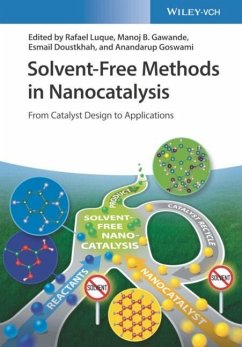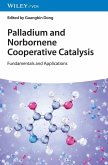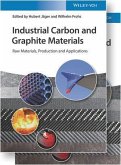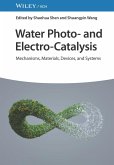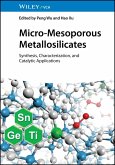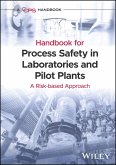Solvent-Free Methods in Nanocatalysis
From Catalyst Design to Applications
Herausgegeben:Luque, Rafael; Gawande, Manoj B.; Doustkhah, Esmail; Goswami, Anandarup
Solvent-Free Methods in Nanocatalysis
From Catalyst Design to Applications
Herausgegeben:Luque, Rafael; Gawande, Manoj B.; Doustkhah, Esmail; Goswami, Anandarup
- Gebundenes Buch
- Merkliste
- Auf die Merkliste
- Bewerten Bewerten
- Teilen
- Produkt teilen
- Produkterinnerung
- Produkterinnerung
Discover solvent-free approaches for the synthesis of nanocatalysts as well as various catalytic transformations in this unique one-stop resource!
Andere Kunden interessierten sich auch für
![Palladium and Norbornene Cooperative Catalysis Palladium and Norbornene Cooperative Catalysis]() Palladium and Norbornene Cooperative Catalysis97,99 €
Palladium and Norbornene Cooperative Catalysis97,99 €![Industrial Carbon and Graphite Materials Industrial Carbon and Graphite Materials]() Industrial Carbon and Graphite Materials282,99 €
Industrial Carbon and Graphite Materials282,99 €![Water Photo- and Electro-Catalysis Water Photo- and Electro-Catalysis]() Water Photo- and Electro-Catalysis112,99 €
Water Photo- and Electro-Catalysis112,99 €![Ionic Liquid Catalyzed Reactions Ionic Liquid Catalyzed Reactions]() Zhimin LiuIonic Liquid Catalyzed Reactions104,99 €
Zhimin LiuIonic Liquid Catalyzed Reactions104,99 €![Micro-Mesoporous Metallosilicates Micro-Mesoporous Metallosilicates]() Micro-Mesoporous Metallosilicates112,99 €
Micro-Mesoporous Metallosilicates112,99 €![CO2 Conversion and Utilization CO2 Conversion and Utilization]() CO2 Conversion and Utilization105,99 €
CO2 Conversion and Utilization105,99 €![Handbook for Process Safety in Laboratories and Pilot Plants Handbook for Process Safety in Laboratories and Pilot Plants]() Center for Chemical Process Safety (CCPS)Handbook for Process Safety in Laboratories and Pilot Plants188,99 €
Center for Chemical Process Safety (CCPS)Handbook for Process Safety in Laboratories and Pilot Plants188,99 €-
-
-
Discover solvent-free approaches for the synthesis of nanocatalysts as well as various catalytic transformations in this unique one-stop resource!
Produktdetails
- Produktdetails
- Verlag: Wiley-VCH
- Artikelnr. des Verlages: 1134874 000
- 1. Auflage
- Seitenzahl: 352
- Erscheinungstermin: 1. März 2023
- Englisch
- Abmessung: 248mm x 173mm x 22mm
- Gewicht: 822g
- ISBN-13: 9783527348749
- ISBN-10: 3527348743
- Artikelnr.: 64561070
- Herstellerkennzeichnung
- Wiley-VCH GmbH
- Boschstraße 12
- 69469 Weinheim
- wiley.buha@zeitfracht.de
- Verlag: Wiley-VCH
- Artikelnr. des Verlages: 1134874 000
- 1. Auflage
- Seitenzahl: 352
- Erscheinungstermin: 1. März 2023
- Englisch
- Abmessung: 248mm x 173mm x 22mm
- Gewicht: 822g
- ISBN-13: 9783527348749
- ISBN-10: 3527348743
- Artikelnr.: 64561070
- Herstellerkennzeichnung
- Wiley-VCH GmbH
- Boschstraße 12
- 69469 Weinheim
- wiley.buha@zeitfracht.de
Rafael Luque is a Professor of Organic Chemistry at the University of Cordoba, Spain. He also served as Director of the Centre for Molecular Design and Modern Organic Chemistry at RUDN University in Moscow, Russia, and Chair in the Department of Applied Chemistry at Xi'an Jiatong University, China. He has published widely on nanomaterials science, heterogenous catalysis, biofuels and green chemical methods in synthetic organic chemistry, and edited 10 books. Manoj B. Gawande is an Associate Professor at the Department of Industrial and Engineering Chemistry, Mumbai Marathwada Campus Jalna, India. He is also visiting Professor at RCPTM-CATRIN, Palacky University, Czech Republic. His research is focused on the development of greener raw materials, single-atom catalysts, materials and their applications in sustainable chemistry. He has published more than 150 scientific publications. Esmail Doustkhah is a senior Research Fellow at the Koc University Tüpras Energy Center (KUTEM), Istanbul, Turkey. Before, he was a JSPS Fellow, postdoctoral researcher, and junior researcher at the National Institute for Materials Science (NIMS), Japan, from 2016 - 2022. His research interests are the design of new layered and porous materials for smart catalysis and photocatalysis. Anandarup Goswami is an Associate Professor in the Department of Chemistry at Vignan's Foundation for Science, Technology and Research (VFSTR), Andhra Pradesh, India, since 2016. He received his Ph.D in Chemistry from Cornell University, New York, USA, in 2010, and did postdoctoral work in both the United States and Europe. His areas of research include applications of functional nanomaterials in catalysis, drug-delivery, and adsorption.
Chapter 1: Introduction to Solvent-Free Methods in Nanocatalysis
Chapter 2: Strategies for the Preparation of Nanocatalysts and Supports under Solvent-Free Conditions
Chapter 3: Solvent and Catalyst-Free Organic Transformations
Chapter 4: Metal Oxides as Catalysts/Supports in Solvent-Free Organic Reactions
Chapter 5: Silica-Based Materials as Catalysts or Supports in Solvent-Free Organic Reactions
Chapter 6: Carbon-Based Materials as Catalysts/Supports in Solvent-Free Organic Reactions
Chapter 7: Nitride Nanostructures in Solvent-Free Catalysis
Chapter 8: Supported Ionic Liquids for Solvent-Free Catalysis
Chapter 9: Present Status & Future Outlook
Chapter 2: Strategies for the Preparation of Nanocatalysts and Supports under Solvent-Free Conditions
Chapter 3: Solvent and Catalyst-Free Organic Transformations
Chapter 4: Metal Oxides as Catalysts/Supports in Solvent-Free Organic Reactions
Chapter 5: Silica-Based Materials as Catalysts or Supports in Solvent-Free Organic Reactions
Chapter 6: Carbon-Based Materials as Catalysts/Supports in Solvent-Free Organic Reactions
Chapter 7: Nitride Nanostructures in Solvent-Free Catalysis
Chapter 8: Supported Ionic Liquids for Solvent-Free Catalysis
Chapter 9: Present Status & Future Outlook
Chapter 1: Introduction to Solvent-Free Methods in Nanocatalysis
Chapter 2: Strategies for the Preparation of Nanocatalysts and Supports under Solvent-Free Conditions
Chapter 3: Solvent and Catalyst-Free Organic Transformations
Chapter 4: Metal Oxides as Catalysts/Supports in Solvent-Free Organic Reactions
Chapter 5: Silica-Based Materials as Catalysts or Supports in Solvent-Free Organic Reactions
Chapter 6: Carbon-Based Materials as Catalysts/Supports in Solvent-Free Organic Reactions
Chapter 7: Nitride Nanostructures in Solvent-Free Catalysis
Chapter 8: Supported Ionic Liquids for Solvent-Free Catalysis
Chapter 9: Present Status & Future Outlook
Chapter 2: Strategies for the Preparation of Nanocatalysts and Supports under Solvent-Free Conditions
Chapter 3: Solvent and Catalyst-Free Organic Transformations
Chapter 4: Metal Oxides as Catalysts/Supports in Solvent-Free Organic Reactions
Chapter 5: Silica-Based Materials as Catalysts or Supports in Solvent-Free Organic Reactions
Chapter 6: Carbon-Based Materials as Catalysts/Supports in Solvent-Free Organic Reactions
Chapter 7: Nitride Nanostructures in Solvent-Free Catalysis
Chapter 8: Supported Ionic Liquids for Solvent-Free Catalysis
Chapter 9: Present Status & Future Outlook

